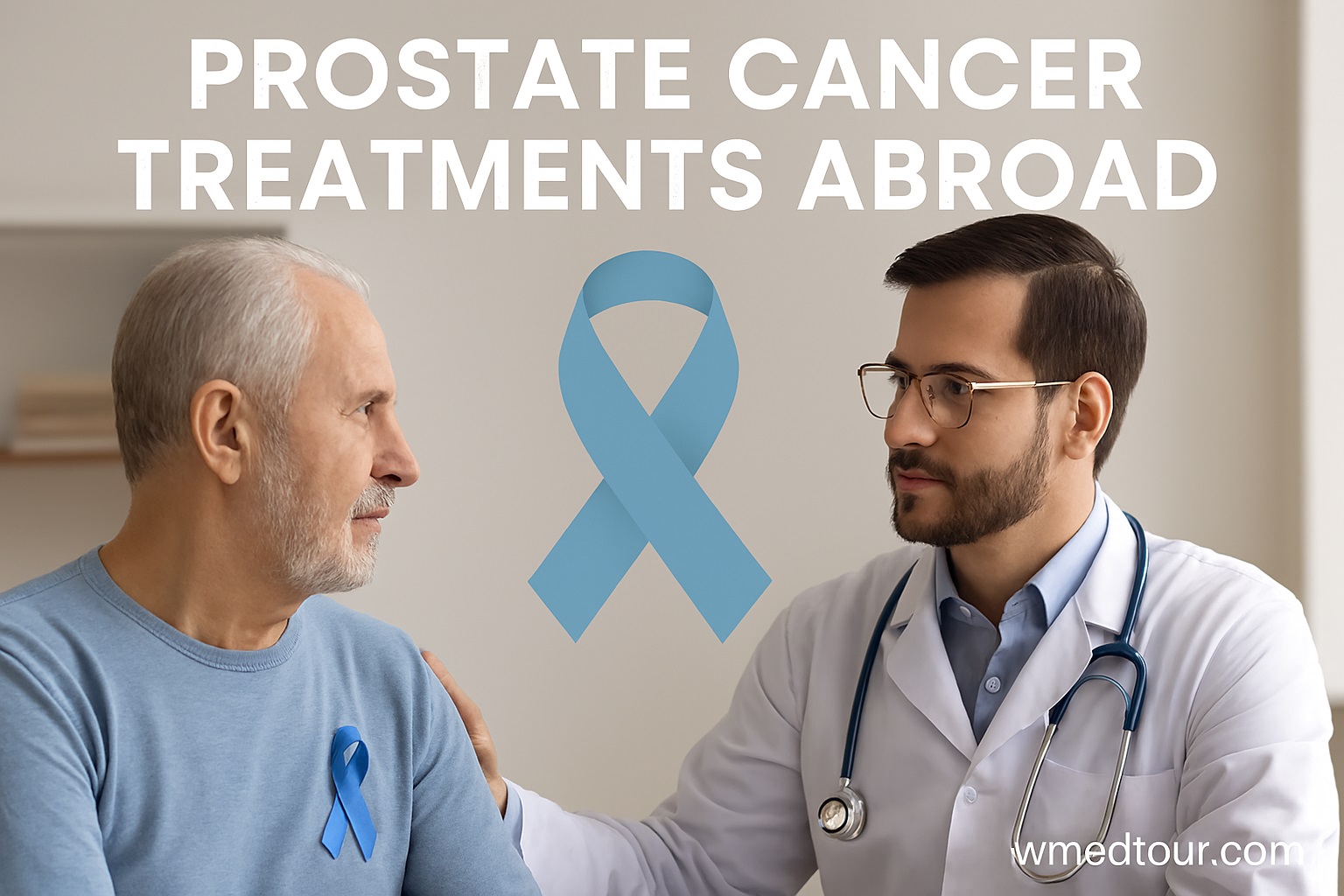Prostate Cancer Treatments Abroad 2025: Your Global Care Guide
To begin with, facing a diagnosis of prostate cancer can be a challenging and, in fact, overwhelming experience. Nevertheless, we are living in a time of incredible medical advancements, and consequently, treatment options are more effective than ever before. While many patients receive excellent care at home, it is true that a growing number of men are exploring Prostate Cancer Treatments Abroad 2025. Indeed, this movement, often called medical tourism, offers an opportunity for affordable, high-quality care, access to innovative therapies, and furthermore, a chance to bypass long waiting lists. Therefore, understanding the global landscape of prostate care can, in essence, empower you to make the very best decisions for your health and, ultimately, your future.
The Diagnosis: What You Need to Know
In the first place, a prostate cancer diagnosis is not a one-size-fits-all situation; on the contrary, it is a highly individualized process that, as a result, determines the best course of action. This typically starts with a Prostate-Specific Antigen (PSA) test and a digital rectal exam (DRE). If these initial screenings raise concerns, doctors often recommend a biopsy. Following this, tissue samples from the biopsy are then analyzed by a pathologist to determine a Gleason Score. In effect, the Gleason Score is a critical tool that, on the one hand, measures the aggressiveness of the cancer cells, while on the other hand, it helps to classify the cancer as low, intermediate, or high-risk.
Furthermore, as a matter of course, staging scans like an MRI or CT scan may be performed to see if the cancer has spread beyond the prostate. This comprehensive evaluation is a vital step because it establishes the precise stage and grade of the disease, which directly and consequentially impacts the treatment options available to you. Understanding these results is, in fact, essential for creating an effective and personalized treatment plan, whether you choose to receive it at home or abroad.
Exploring Surgical and Non-Surgical Options
When it comes to treating prostate cancer, you have a wide range of options to consider. To begin with, for localized cancer, the primary choice is often a radical prostatectomy, which is the surgical removal of the prostate gland. While traditional open surgery remains an option, most leading medical centers today perform this procedure using robotic-assisted technology. This method, which utilizes a precise, surgeon-controlled robot, often results in less pain, minimal blood loss, and a faster recovery.
In contrast, radiation therapy is a popular non-surgical alternative. This approach uses high-energy rays to destroy cancer cells and, more specifically, can be delivered externally or internally via brachytherapy, where small radioactive seeds are placed directly into the prostate. Additionally, for low-risk cases, many doctors recommend active surveillance, which involves regular monitoring rather than immediate intervention. In this way, this can help patients avoid the potential side effects of more aggressive therapies.
Advanced Therapies and The Rise of Medical Tourism
The field of oncology is, in point of fact, constantly evolving, with new advanced therapies offering hope to patients with more complex cases. Hormone therapy, for instance, is used to block the male hormones that fuel cancer growth, thereby slowing its progression. Similarly, chemotherapy and immunotherapy are effective for advanced or recurrent prostate cancer. Additionally, new technologies like HIFU (High-Intensity Focused Ultrasound) and proton therapy are becoming more accessible globally, thus offering precise and less invasive treatment options.
Consequently, many patients are looking for Prostate Cancer Treatments Abroad 2025 to access these cutting-edge options. The reasons are clear: they often find the same or, in fact, even better quality of care at a significantly lower cost. A significant number of international hospitals have invested heavily in technology that may not be widely available in other countries. Therefore, medical tourism provides a viable and often superior alternative for many patients seeking advanced prostate care.
Choosing Your Destination: A Comparative Look
On the whole, selecting the right country for your medical journey requires a great deal of careful consideration. Different nations specialize in various aspects of medical care, offering unique advantages. For example, some countries are renowned for their expertise in robotic surgery, while others, in contrast, are leaders in immunotherapy. It is, therefore, essential to research the certifications of the hospitals and the credentials of the surgeons. As a great way to begin, you can visit a reputable medical tourism facilitator like WMedTour, which can provide guidance and connect you with top-tier hospitals.
Comparison of Top Destinations for Prostate Cancer Treatment
| Destination | Key Strengths | Typical Cost Range | Noteworthy Hospitals |
|---|---|---|---|
| Turkey | Robotic surgery, cost-effectiveness, high-volume centers. | $10,000 – $25,000 USD | Acıbadem, Memorial Healthcare Group |
| Germany | Advanced diagnostics, strict quality control, proton therapy. | $20,000 – $45,000 USD | University Hospital Heidelberg |
| South Korea | Technological innovation, precision medicine, personalized care. | $25,000 – $50,000 USD | Severance Hospital, Asan Medical Center |
| Thailand | Excellent service, resort-like recovery, affordability. | $8,000 – $20,000 USD | Bumrungrad International Hospital |
| Iran | Highly skilled surgeons, very low cost, specific expertise in oncology. | $5,000 – $15,000 USD | Jam Hospital, Mahak Hospital |
Note: Costs are estimates and can vary based on individual cases and hospital.
The Patient Journey: A Step-by-Step Guide
Embarking on a medical journey abroad can, in fact, feel daunting, but a structured approach can make it seamless. First, you should gather all your medical records and share them with a medical tourism company. Then, they will help you get a consultation with a specialist abroad and obtain a treatment plan. Once you confirm the plan, the company will, furthermore, help with all logistics, including travel, accommodation, and visas. In addition, they will arrange for airport transfers and a translator to assist you during your stay.
During treatment, the foreign hospital and your medical tourism company will, of course, work together to ensure you receive the highest standard of care. After the procedure, you will typically remain in the country for a period of recovery before you fly home. Post-treatment follow-up is also coordinated, ensuring continuity of care. Ultimately, with proper planning and the right support, your journey to global prostate care can be a smooth and positive experience.
Important Questions to Ask
Before committing to a provider, you should, of course, ask key questions. For example, inquire about the surgeon’s experience and the hospital’s specific success rates for your type of cancer. It is, moreover, important to ask about what is included in the treatment package, as well as the cost of any potential follow-up care. In addition, discuss communication protocols with the medical team, ensuring that you will have access to a translator or a staff member who can speak your language.
You can find more helpful information from organizations such as the National Cancer Institute or, alternatively, the Mayo Clinic. Conversely, for insights on the patient experience, consider resources from the Prostate Cancer Foundation. These resources offer valuable perspectives on all aspects of the disease and its treatments.
Your Path to Recovery
Choosing the right prostate cancer treatment is one of the most significant decisions you can make. The global medical landscape offers an incredible array of opportunities, but it is, in fact, a complex field to navigate alone. That’s where WMedTour can help. As a trusted medical tourism partner, they simplify the entire process by connecting you with JCI-accredited hospitals and top-rated specialists worldwide. Furthermore, they handle all the logistics, thereby allowing you to focus completely on your health and recovery.
To conclude, the future of prostate cancer treatments abroad 2025 is bright and full of possibility. The key is, of course, to be informed and proactive. By taking these steps, you can take control of your health journey. Whether you are seeking a second opinion or are ready to book your treatment, a professional partner can, in fact, make all the difference. Visit wmedtour.com today and let them guide you to the best possible outcome.




